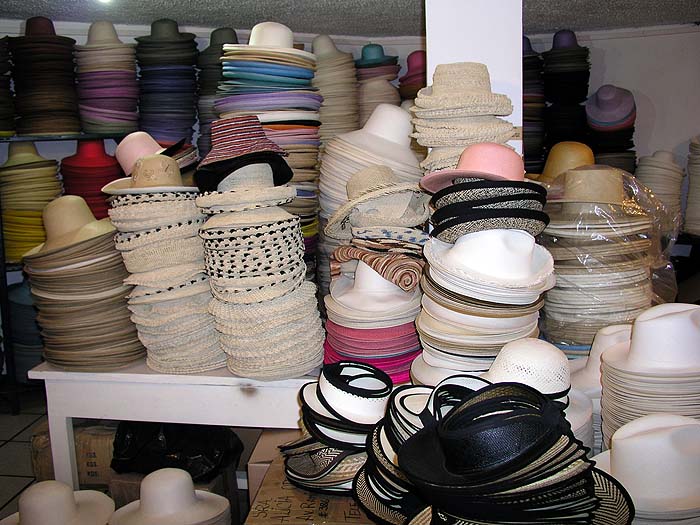His search for the perfect headgear gave Johnny Morris just the excuse he needed to visit a small South American country and acquaint himself with the lives and skills of workers in the panama hat industry.
Like most balding men, I have a weakness for smart hats; and recently, I developed a passion for the panama.
The white summer trilby beloved by the old guard of the Marylebone Cricket Club at Lord's is a design classic. It's effortlessly elegant: try picturing Robert Redford playing the Great Gatsby wearing a baseball cap.
It is also very practical - it keeps your crown cool and protected from UV rays in the mad-dog midday sun. Plus it's a hat with a fine pedigree, worn by many of the great movers and shakers, from Napoleon to Churchill and Khrushchev through to super-cool Johnny Depp.
So where do these stylish hats come from? Give yourself nul points and pay more attention if you thought it was Panama. As any pub quiz aficionado knows, the hat is a product of Ecuador.
I did further research, and discovered that the panama comes in shapes and styles with evocative names such as plantation, aficionado and borsalino; that some panamas sell for thousands of pounds; and that a version of the classic hat is still worn by indigenous women of the Andes.
By now the idea of travelling to a South American country straddling the Equator in search of the perfect panama was hard to resist.
The travel plans
I approached a company called Last Frontiers, which specialises in tailor-making trips to Latin America.
We started by discussing its sample itineraries for Ecuador, and then homed in on the best regions for my quest.
A guide in Quito was contacted for suggestions as to where to buy the best panamas. Then an itinerary was prepared for me and my flights were booked.
The great thing was that it still felt like an adventure, for Last Frontier's philosophy is to help with pre-trip planning but leave travellers to discover the country for themselves.
In all, I spent a week in Ecuador: flying into Quito, on to Cuenca and then down to Guayaquil. After endless hat chat with expert makers, this is what I learned:
The local lowdown
There are two distinct centres of excellence for panama hats in Ecuador: one on the Pacific coast; the other high up in the Andes.
The art of making hats from palm fronds originated in the towns of Montecristi and Jipijapa, close to the coastal resort of Manta. Here you can see the palm growing in its natural habitat, and find a handful of weavers who still produce the legendary extra-fine Montecristi hats: the best grade of panamas, which can carry diamond-ring price tags and take up to six months of skilled weaving to produce.
In contrast, the Andean mountain city of Cuenca and its surrounding villages concentrate on quantity.
Here a thriving cottage industry produces a stockpile of sombreros de paja toquilla. These handmade hats may not be quite as refined as the Montecristis, but the scale of the output means that there is more choice for the visitor and guaranteed regular work for the weavers.
The hat makers
The key to the classic hat's appeal is that it is made from one of nature's miracle materials: the toquilla palm. Thin strips of fronds are woven together in a tight circular pattern to create a fabric that's as soft and light as linen, robust enough to roll, and dense enough to shield you from the tropical sun.
The unsung heroines of the hat story are the women who weave them. They are called toquilleras.
To meet these skilled artisans and support a successful fair-trade initiative, you should travel to remote Sigsig, 40 miles south-west of Cuenca.
There you will find the headquarters and shop for ATMA, the largest association of toquilleras in the area, and the only one that commands the whole process from weaving to export.
They produce a great range of hats from their classic panamas - as featured in the latest Harry Potter film - to jazzy two-tone fedoras. ATMA keeps huge stocks of panamas, so you can match any style with any hatband you fancy. Adjustments are made on site; new designs and unusual sizes can be woven specially.
The sellers
There are several great hat shops worth visiting in Cuenca, but most agree that Homero Ortega's family business is the best.
Their factory and shop is opposite the main bus depot in an unpromising part of new Cuenca. Don't be deterred by the nondescript premises, however, because inside is hat heaven - an Aladdin's cave of superb sombreros de paja toquilla.
Visitors are welcome, and free to wander through the factory to see the various finishing techniques; there is a small display explaining production from palm to weave.
You can buy and try your hat in the formal showroom or, better still, hunt through the storeroom where there are thousands of hat styles, shapes and sizes to choose from. Standard panamas are bargains, costing between £4 and £10, while the stocked top-quality hats cost from £20 to £300.
The purchase
The quality of a panama is traditionally judged by the number of weaves per inch of material. The finer the individual strands of paja toquilla, the longer it takes to weave. So, for a quick assessment, hold the hat up to the sun and see how much light comes through: the fewer the pinpricks of light, the tighter and finer the weave, the better the quality, the higher the price and the greater protection for your head.
Fifteen strands per inch is regular weave, 18 is a good quality, and with 25 or more you have a serious piece of craftsmanship in your hands. Always check for an even circular crown, and a brim with good finishing - that is, no stray strands or heavy knots (and avoid brittle toquilla palm).
The other sights
There is a lot to discover in addition to hat-making in the Unesco World Heritage site of Cuenca. This colonial city is a centre for arts and handicraft. Look out for artisan shops selling excellent religious paintings, guitars, pottery, tiles and intricate embroidery.
If you are travelling to the weaving centre at Sigsig, be sure to visit the attractive nearby town of Chordeleg, known for its silversmiths and high-quality jewellery.
Guayaquil, the commercial hub of Ecuador, is much under rated as a tourist destination, but its tropical atmosphere provides a welcome contrast to the chilly towns of the Andes. The old district of Las Peñas and the new Malecón 2000 (promenade) are best for nightlife - but the headgear is strictly baseball caps, without a panama in sight.
The verdict
4 out of 5 - superb, grassroots craftsmanship set against the dramatic backdrop of the Andes.

